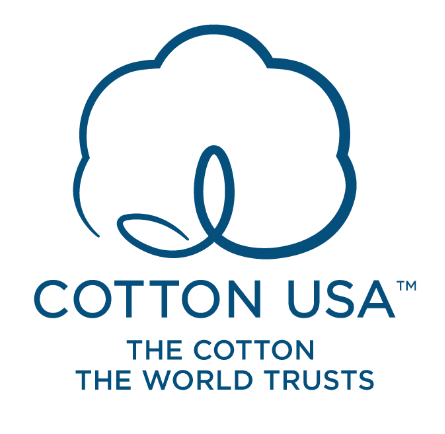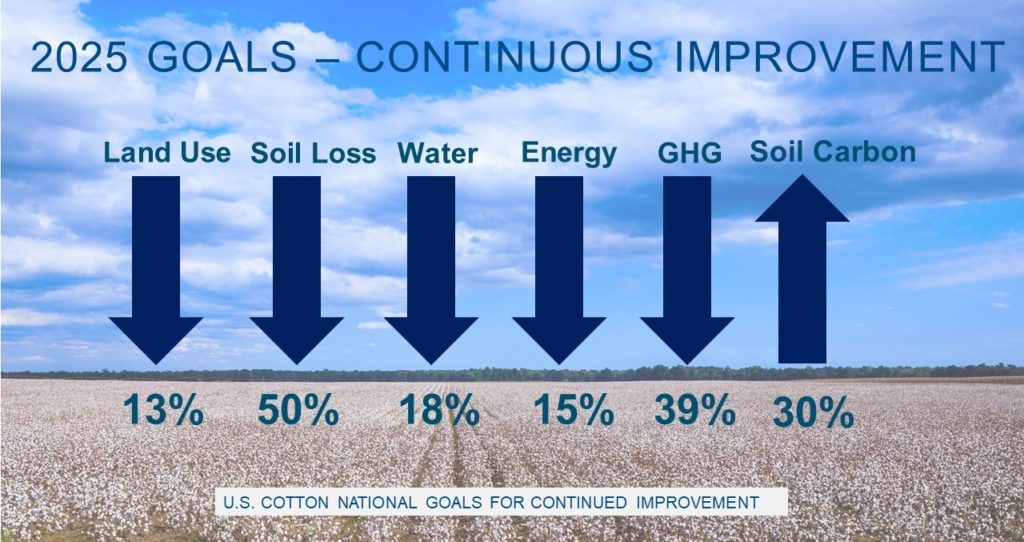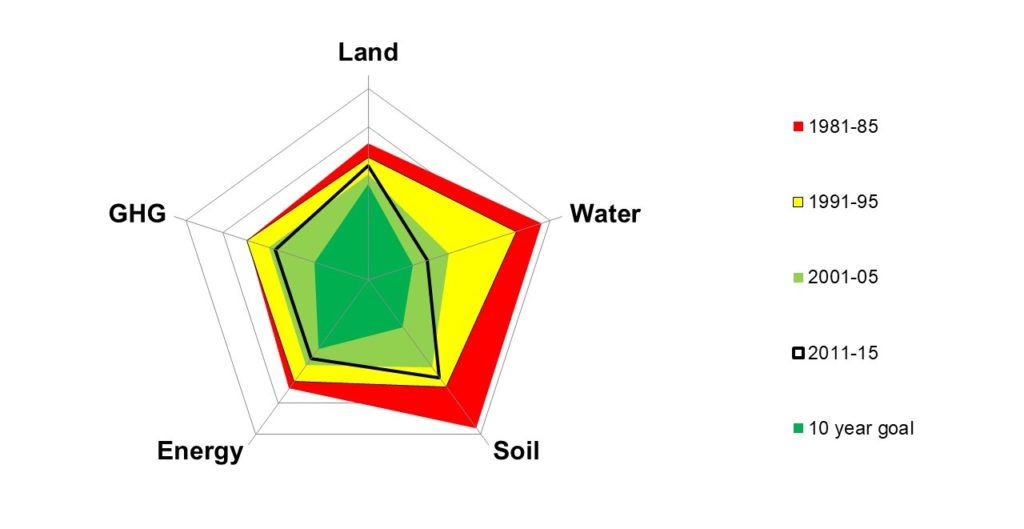COTTON USA. Cotton for a greener, kinder world
 Commitment and innovation define U.S cotton production. From 21,503 square miles of farmland in 17 states springs Upland and American Pima cotton – diverse, top quality fiber to fit any customer’s needs. Upland cotton is grown in four major geographic areas of the U.S: The Southeast, Mid-South, Southwest and West, collectively called the Cotton Belt.
Commitment and innovation define U.S cotton production. From 21,503 square miles of farmland in 17 states springs Upland and American Pima cotton – diverse, top quality fiber to fit any customer’s needs. Upland cotton is grown in four major geographic areas of the U.S: The Southeast, Mid-South, Southwest and West, collectively called the Cotton Belt.
At COTTON USA, the growers produce sustainable and fairly grown cotton. The family farmers own the land. Their fields have been in their families for generations—it’s in their own best interest to protect them for future generations. They have one of the highest rates of adoption in the world for Precision Agriculture, which encourages less water and pesticide usage. And U.S farmers operate under voluminous, stringent, and enforceable regulations. Finally, COTTON USA has one of the most comprehensive systems for monitoring and measuring all the key metrics involved in sustainability.
U.S. cotton trust protocol
 Over the last 35 years, the Commitment of U.S cotton producers, researchers, and industry organizations led to dramatic reductions in land use, soil loss, water use, energy use and greenhouse gas emissions. For the next decade and beyond, U.S cotton producers and Industry organizations have set a new standard in sustainable cotton production “U.S. Cotton Trust Protocol”.
Over the last 35 years, the Commitment of U.S cotton producers, researchers, and industry organizations led to dramatic reductions in land use, soil loss, water use, energy use and greenhouse gas emissions. For the next decade and beyond, U.S cotton producers and Industry organizations have set a new standard in sustainable cotton production “U.S. Cotton Trust Protocol”.
US. Cotton Trust Protocol is a sustainable program that has been established in order to enable cotton producers and industry organizations to demonstrate their commitment to more sustainable cotton production and their progress towards long-term environmental improvement, thereby meeting the demand of the consumers who are now looking for sustainable cotton products.
The new U.S. Cotton Trust Protocol is a tangible and transparent snapshot of U.S cotton growing practices and the gains in the sustainability standards resulting from them. It’s an integrated data collection, measurement and verification system that will document U.S cotton production practices and their environmental impact. U.S cotton producers will enroll their farm operation in the U.S. Cotton Trust Protocol by filling up a questionnaire containing questions about their current farming operations and methods (self-assessment); and then providing the asked field-level data, related to the production practices exercised for a specific percentage of their farming operation known as the Data Tool. The questionnaire covers the best management practices covering soil health, nutrient management, water management, crop protection, harvest preparation, wildlife habitat, fiber quality and traceability, farm management and worker’s relation.
The producer’s self-assessed responses and use of Data Tool for field level data are then verified by a second-party and third party independent verification systems. Cotton produced under this Protocol will be deemed as ‘Protocol Cotton.’ The data provided through the self-assessment and Data Tool will then be aggregated and utilized to measure the industry’s progress in accordance with the sustainability goals. The Permanent Bale Identification (PBI) system, which helps in tracing down cotton from the fields to the mill laydown, is a unique feature offered by U.S cotton. The PBI system helps in assuring that no environmental or social reputational risks are associated with U.S cotton.
Science-based targets:
Some of the leading textile and fashion industry participants have made commitments to Sustainable Development Goals, United Nation Climate Change, G7 Fashion Pact and others which are based on the science based targets covering a wider landscape like climate change, restoring biodiversity, protecting the oceans, energy and water efficiency in the value chain and increasing land productivity. U.S. Cotton Trust protocol is aligned with the industry goals and commitments and provide measurable progress on the science based targets.
Reduce land use by 13%
The effective use of agricultural land is critical to creating more sustainable future. Population growth and the related increased demand for food and fiber necessitates a need to maximize land use efficiency, or yield.
The U.S cotton industry continues to increase its land use efficiency by:
- Increasing cotton fiber yields through better genetic varieties and appropriate grower management.
- Reducing the amount of water per pound of cotton, especially with highly uniform water delivery systems.
- Improving soil health through crop rotation, no-till practices, and the planting of cover crops: and
- Implementing improved irrigation scheduling tools.
Research aimed at increasing cotton yields and reducing cotton land use are seen as key priorities for reaching the sustainability goals while also increasing the profitability of growers.
Decrease soil loss by 50%
Soil conservation efforts are high priority for cotton farmers as Soil losses can create environmental degradation, reduce farm productivity and decrease quality and quantity of usable soil. While cotton field soils are continually produced from parent material, the industry goal is to produce more new soil than is lost due to water or wind erosion.
From 1980 to 2005, large numbers of cotton growers in the Mid-South and Southeast adopted conservation tillage to reduce soil erosion. This land use pattern was aided by the launch of cotton varieties tolerant to broad-spectrum foliar herbicides in 1997, and by their rapid adoption across the U.S cotton Belt over the next five years. More recently, grower interest in cover crops for weed suppression and for soil health has extended the protection of soil to intense rainfall. Cover crop adoption for weed control and soil health will continue to be an important component of continuous efforts of the U.S cotton industry.
Decrease water use by 18%
Cotton is an inherently drought tolerant crop, however, in some regions of the U.S, cotton fields are irrigated to increase productivity. Increasing water-use efficiency (WUE) would allow growers to produce more cotton using the same amount of water; doing more with less. This increase would help the U.S cotton industry meet the demand for more sustainable fibers while using less resources per pound of cotton.
Over the past several decades, U.S cotton growers have increased yields without increasing water use. This historical progress has been achieved through the use of tools and practices such as the implementation of better water delivery systems and use of improved irrigation scheduling tools. The trend of increased yields without increased water use will continue, as the adoption of irrigation scheduling technologies is promoted.
Decrease energy use by 15%
The primary energy expenditures in cotton production include manufacturing nitrogen fertilizer, harvesting, ginning and tillage. U.S cotton growers began reducing their energy expenditures in the 1980’s by employing reduced tillage and reducing nitrogen applications per pound of fiber produced. Since the energy requirements for harvesting and ginning are relatively constant, the pathway to further decreases will be addressed by increase in the number of growers employing reduced tillage and reduced nitrogen applications, as well as emerging technologies.
Several promising technologies will be available in 10 to 30 year time frame that will lower the harvesting and ginning energy consumption, including:
Robotic Technologies: Robotic implements are available for factory and residential cleaning. Considering the large market for robotic implements in agriculture, these will be entering the market soon and will lower cotton harvesting energy use and cost.
Gene editing of fiber to seed attachment force: Even without a major improvement in machinery, it is anticipated that gene editing will facilitate development of cotton varieties with lower gin energy costs due to the ability to manipulate the fiber to seed attachment force (ginning represents approximately 25% of the U.S cotton energy footprint for non-irrigated conditions)
Decrease greenhouse gas emissions by 39%
Cotton growth naturally removes Carbon Dioxide from the environment through photosynthesis, however the use of fertilizers and other on farm activities release Carbon Dioxide and other greenhouse gas (GHG) to the environment.
One of the strongest contributors to cotton’s agricultural GHG footprint is the use of synthetic nitrogen(N) and its energy intensive manufacturing process. In addition, N is a strong GHG contributor because a small percent of applied N fertilizer is lost to the atmosphere as nitrous oxide, a potent GHG. The cotton industry is working with scientist to decrease the amount of nitrogen required to produce each pound of cotton through efforts to increase Nitrogen use efficiency (NUE). Refined management systems are calling for precise amounts of nitrogen to eliminate waste and over application. With increased use of site-specific management and new technologies such as on-the-go sensors, there will be increase in NUE and corresponding decreases in GHG emissions.
Increase soil carbon by 30%
Increasing soil carbon, often referred to as regenerative agriculture, is seen by many organizations as a key strategy to reducing atmospheric greenhouse gas (GHG) that leads to climate change. The soil carbon measurement is important not only for understanding carbon flows to and from cotton fields, but it is also an accepted indicator of soil health.
The USDA’s Natural Resource Conservation Service (NRCS) Soil Conditioning Index (SCI) provides guidance on practices that increase organic matter, or carbon, in the soil and is used as the KPI for this sustainability goal. An increase in the SCI by 30% means an increase in the number of fields that are increasing soil organic matter. The primary actions to improve soil health are the use of cover crops and reduced tillage. Currently, approximately half of U.S growers currently use winter crops, and no-till adoption has increased from 36% to 45% from 2008 to 2015, respectively. There is a significant growing interest in the use of winter crops by U.S producers and there has been an increasing trend towards no-tillage and strip tillage. In addition to reducing the amount of GHG released to the atmosphere, improving soil health can also contribute to: increased crop yields; reduced water use; increased nutrient uptake; reduced fertilizer use; reduced nutrient runoff; and reduced soil loss.
The Value Preposition:
Brands and retailers who choose the Trust Protocol are given access to the data that measures the progress with respect to the sustainability goals. This helps them to deliver the right message and market their brand positively to their customers. For some organizations, it is important to be able to show to stakeholders that their cotton is being produced using standards and with independent verification. The Trust Protocol will be a further metric that will enable them to show how you are meeting your goals, commitments and pledges regarding global initiatives on climate change and sustainability, as well as those specific to apparel and textiles sectors. Depending on the membership level the organisation would be able to:
- Receive the data from Trust Protocol growers through the detailed questionnaire of production/labor practices and metrics from our data partner Field to Market-The Alliance for Sustainable Agriculture that will track progress towards industry goals and commitments.
- The right to receive and claim volume-linked credits from the Trust Protocol database.
- Trust Protocol logo for corporate materials (all members).
- Recognition on the Trust Protocol website.
- Communications toolkit to support sustainability and traceability storytelling to shareholders, employees and customers, including custom content for your annual report.
In conclusion, The Trust Protocol adds independent, data-driven verification to U.S cotton’s world-leading sustainability, guaranteeing the quality and social responsibility that brands and retailers need to keep their promises to consumers and shareholders.
About Cotton Council International:
Cotton Council International (CCI), the export promotion arm of the National Cotton Council of America (NCC), is a non-profit trade association that promotes U.S cotton fiber and manufactured cotton products around the globe with our COTTON USA trademark. CCI has 60 years of experience promoting U.S cotton fiber and products to trade and consumers.
CCI works with spinning mills, fabric and garment manufacturers, brands, retailers, textile associations, governments and the USDA to facilitate the use of U.S cotton. Our reach extends to more than 50 countries through 20 offices around the world.
For more information, kindly visit www.cottonusa.org and www.trustuscotton.org or you can drop your questions to Mr. Kraipob Pangsapa at kpangsapa@cotton.org


